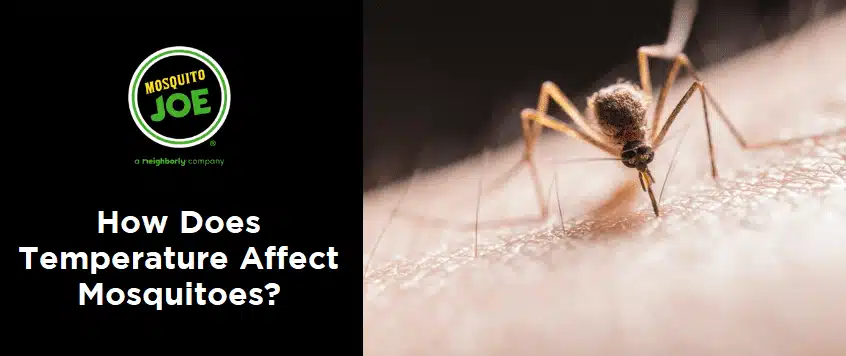We all know that, as the summer heats up, so do the mosquitoes. But we often get asked why this happens, and why we don’t see as many when the temperatures drop. We thought it would make an interesting blog post to break down the impact of temperatures on mosquitoes.
Mosquitoes are incapable of regulating their body temperature as they are cold blooded. This has an impact on when we see them and where, since their body temperature will essentially be the same as the environment, they are in. It’s the reason why we see them in the shade but not the sun – a mosquito venturing out into the Texas sun during the day will get a nasty surprise and not live to talk about it.
Essentially, there are some temperature parameters for the mosquito that we can follow. Temperatures under 50 degrees F force the mosquito into hibernation. Some mosquitoes will die, but others, already lethargic when the temperature drops into the mid 50’s, will shelter under leaves and may live to see the temperatures rise again. In Texas that may only be a few days, as we like to ping pong from cold to hot in the cooler months. Some species of mosquito are much better at dealing with the weather changes, while others will perish once the temperatures reach a low level. Female mosquitoes preparing to lay eggs will often hibernate and lay them when the temperatures warm.
On the other side of the scale, we have heat. Mosquitoes don’t enjoy incredibly high temperatures, but they have evolved over millions of years to develop coping strategies to deal with them. Mosquitoes will come out at night to feed, bite, and mate, and then shelter in the shade during the day waiting for the temperatures to drop down again.
As we continue to see weather changes worldwide, so too do we see changes in mosquito presence. Over the decade between 1980 and 1990, mosquito season in New York City was about 141 days long. In 2006, it was 153 days long. As our temperatures increase, so too do the number of days when mosquitoes coexist with us. In 2021, the increase in storms and rain that summer, along with the warmer than expected temperatures, resulted in a 300 fold increase in mosquitoes in Tammany Parish, LA, while Luzerne County, PA, reported more mosquitoes in 2021 than the combined total from the previous 10 years.
As is typical in Texas, we had a “practice summer” in April this year, followed by a long, endless deluge of rain in May, which resulted in a rather epic mosquito population as we entered June.
But the real key to the population are the mosquito eggs. We tell everyone who will listen just how amazing mosquito eggs are. You can freeze one in a block of ice and melt it a few years later, and it will hatch. You can shelve a mosquito egg for 10 years, and then apply a drop of water to it and it will hatch.
The fact of the matter is, while mosquitoes are impacted by temperatures, mosquito eggs are not. After a ton of rain, mosquitoes will lay eggs, in groups of 300 at a time, everywhere there is standing water. Those eggs will lie in wait, if the temperatures are too cool, until the right time and then they hatch. Once the temperature hits 50 degrees they are off to the races. Sometimes, the area where they are laid dried up, but that’s ok. They will just wait for some new rain and then hatch.
What is crazy to think about is the rapidity with which a mosquito populates its space. Let’s say a female (Aedes) mosquito flies out of the woods into your yard and finds a hole in a tree trunk with water inside, or a pool deck drain holding water under the ground. She pauses and lays her 300 eggs and moves on. And let’s say that 50% of those 300 eggs become females, which will occur about 4-6 days later. You now have 150 females, who will hatch, immediately breed, find a blood meal, and lay their 300 eggs. Eight to twelve days after the female first arrived, you now 150 females producing 150 females a piece, or 22,500 females. Twelve to eighteen days after the first arrived those 22,500 females produce 150 females a piece, and you have 3.3 million females in your yard. In two weeks! Granted some of the original females will no longer be with you, but at this point we don’t think it would matter.
In summary, it’s more than the temperature that impacts the population – it’s the weather and the rain and the locations in your yard that provide the perfect place for egg laying. The perfect storm is Texas weather. Rarely under 50 degrees, often hot and usually humid with rain.
If you want to know how to control your population check out some of our earlier blog posts that provide some great advice. Or you can just call us, and we can take care of your yard for you with one of our treatment options!
Searching through dozens of home and commercial service providers is a thing of the past. Rely on Neighborly’s national network of trusted, local service professionals for all your home and commercial service needs.





 App Store
App Store
 Google Play Store
Google Play Store